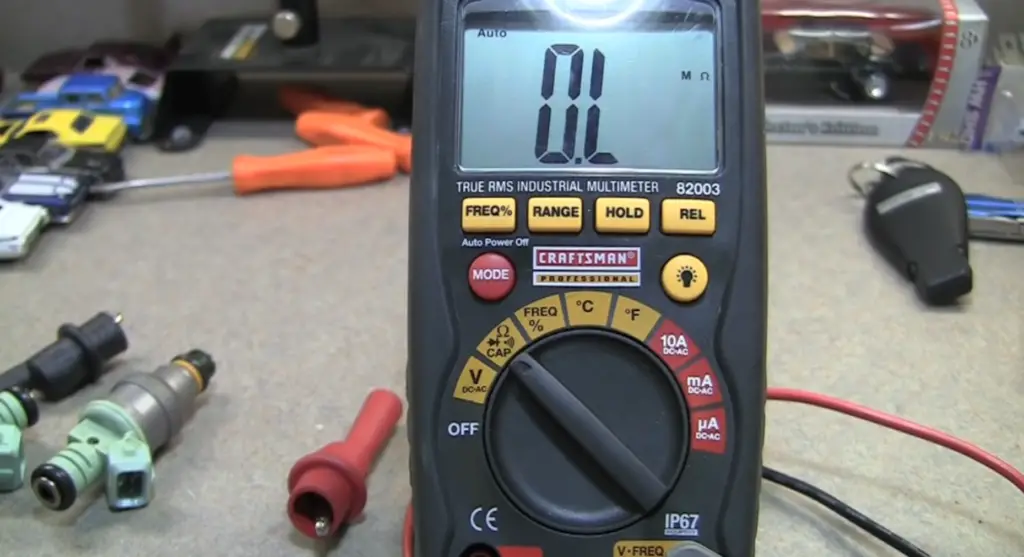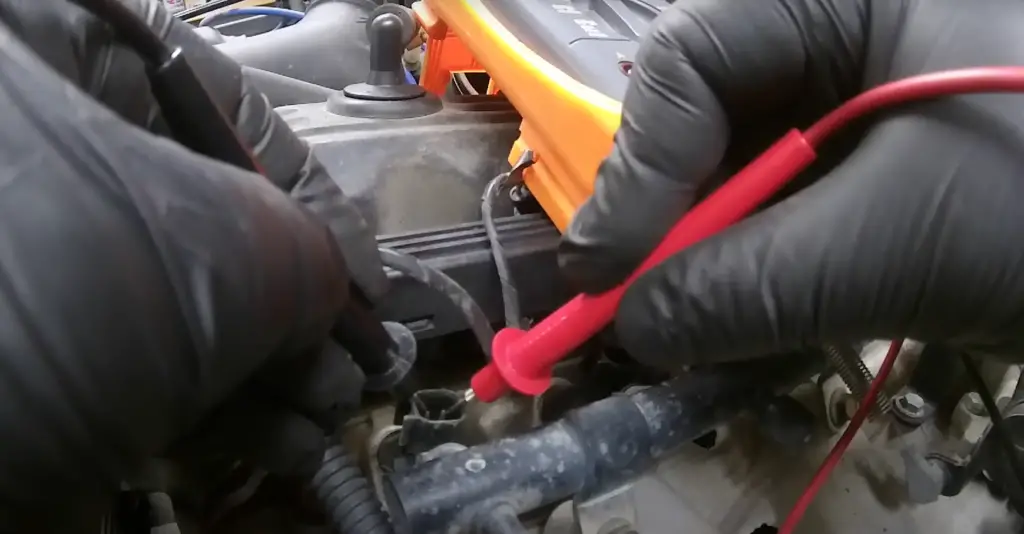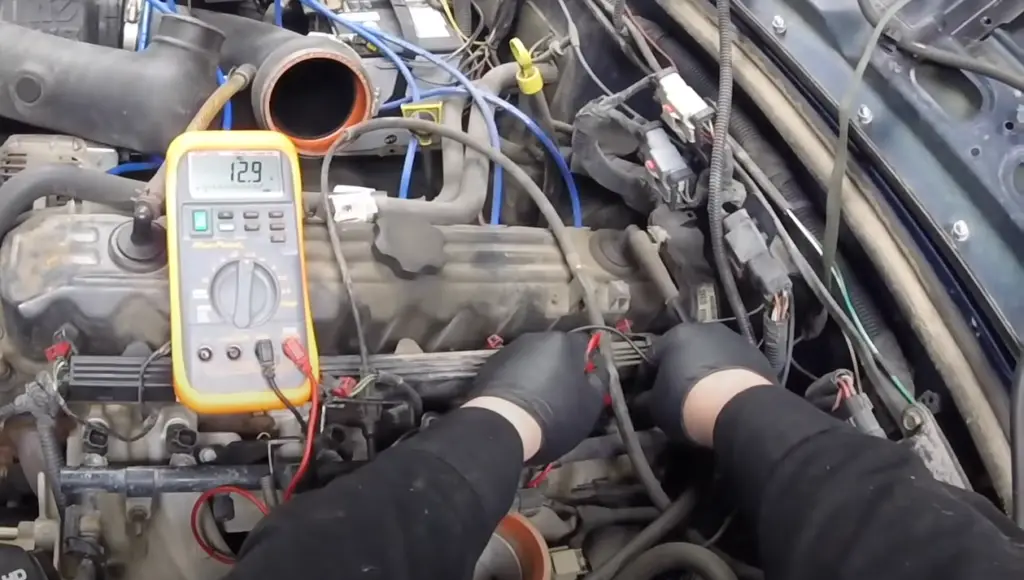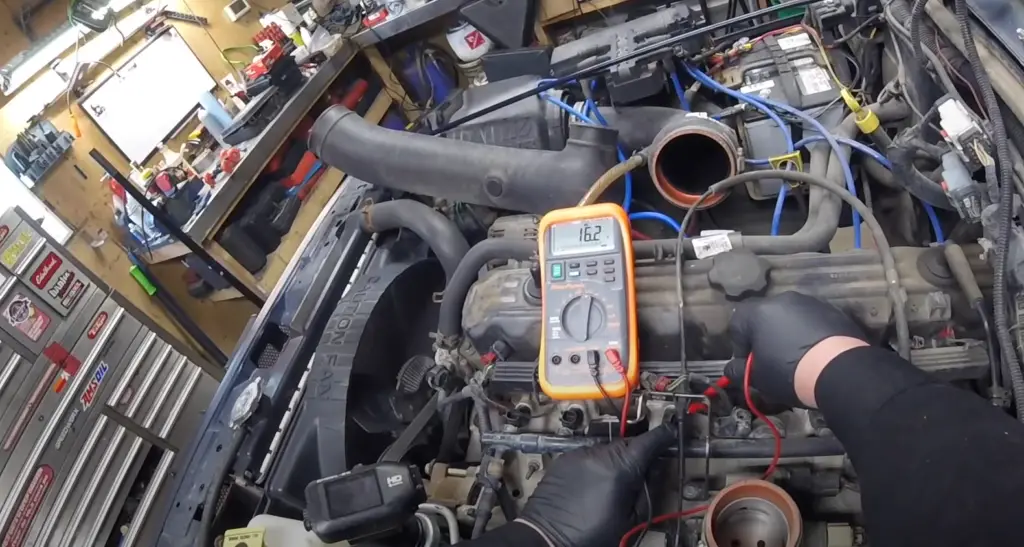Although testing a fuel injector may seem like a daunting task, it’s actually quite simple – and you can do it at home with just a multimeter. In this blog post, we’ll walk you through the steps of how to test a fuel injector with a multimeter, so you can get your car back on the road in no time. Let’s get started!
What Is a Multimeter?
Multimeters have been around since the 1920s and have become a common tool for technicians across many industries. A multimeter helps diagnose problems in automotive, household electronics, and even industrial machinery. [1]

What Is a Fuel Injector?
It works by spraying a fine mist of petrol or diesel into the air intake manifold, where it is ignited and combusts to power the car. The amount of fuel delivered depends on how long the injector remains open; this is determined by signals from the Engine Control Unit (ECU).
When a fuel injector malfunctions, it can cause poor engine performance and reduce your vehicle’s efficiency. To pinpoint any issues with your fuel injectors, you will need to employ a multimeter for a comprehensive diagnosis. This article explains how to do this safely and effectively. [2]
How To Test a Fuel Injector With Multimeter
Step 1 – Identifying the Fuel Injector
Pinpoint the fuel injector in your engine by locating the fuel rail. The fuel rail is a metal tube that supplies fuel to all of the individual cylinders in the engine through the use of separate hoses for each cylinder.
Step 2 – Disconnecting and Removing Fuel Injector
Before testing, you will need to disconnect and remove the faulty injector from its hose. To do this you will need to locate the electrical plug from where it connects to either side of the injector, then unplug it and unscrew or loosen any mounting bolts that might be holding down an upper retaining bracket. With these undone, carefully pull out the entire unit including its hose while preventing any gasoline spillage.
Step 3 – Setting the Multimeter
Once you have removed the faulty injector, it’s time to set up your multimeter. Set the dial of your multimeter to ohms, and then connect the two probes from the multimeter to either side of the fuel injector where you had previously unplugged it.
Step 4 – Testing
Now that everything is connected, press down on the black probe with one hand and in a quick motion press and release the red probe. Watch for a quick spark between them when they are released as this indicates that your injector is getting power from its electrical plug. If there is no spark or steady current then there might be a fault in either its wiring connector or circuit which would need further investigation.
Step 5 – Comparing Results
Once the multimeter indicates a spark, compare it to the results of the next injector in line. Ideally you should see similar sparks between both injectors. If not then there might be an issue with either your fuel pump or fuel injector wiring which would need further investigation and possibly repair or replacement.
Step 6 – Reassembling
When you have finished testing, carefully reassemble everything back together including reconnecting any electrical plugs, tightening mounting bolts, and replacing any hoses that had been removed during the process. Once all is done, your engine should be ready for use again without any further issues. [3]

Signs Of Bad Fuel Injector
A faulty fuel injector can lead to a variety of problems with your vehicle, including reduced power and acceleration, poor fuel economy, excessive emissions, or engine misfires. The following are signs that you may have a bad fuel injector:
- Difficulty Starting Engine – If the engine takes several cranks to start up and has trouble starting at all, this could be caused by a malfunctioning fuel injector.
- Check Engine Light – Malfunctioning fuel injectors often trigger the check engine light in your dashboard.
- Rough Idling – When the vehicle is idling, it should remain steady without any indication of roughness. Bad fuel injectors can cause your car to vibrate and shake when it’s sitting still.
- Misfiring Engine – Bad injectors can cause your engine to misfire, resulting in a decrease in both power and acceleration.
- Strong Fuel Smell – If you smell gas fumes around the car, this could indicate that fuel is leaking from the injector and into the vehicle itself.
If you suspect you have bad fuel injectors, it is recommended that you get them checked by a professional mechanic as soon as possible. This will not only help diagnose any problems but also prevent further damage to other components of your car.

Pros And Cons Of Multimeter Fuel Injector Testing
Multimeter fuel injector testing is a cost-effective and relatively simple way to test your fuel injectors for proper operation. It can help you diagnose problems with your vehicle’s engine, such as poor performance or excessive emissions. However, it does have its disadvantages.
Pros:
- Multimeter fuel injector testing requires minimal tools and setup. All you need is a multimeter and some basic electrical knowledge to get started. It’s also an inexpensive way to test fuel injectors since the only cost is buying the multimeter itself.
- The results are reliable and accurate, which means that this type of testing won’t lead to any false positives or inaccurate readings.
- With multimeter testing, you can pinpoint issues with specific injectors and isolate them for further diagnosis or repair.
Cons:
- Multimeter fuel injector testing is time-consuming. It takes more time to set up the multimeter and run the tests than it does to simply replace a faulty fuel injector outright.
- If you’re not familiar with electrical systems, then reading the results of a multimeter test can be confusing. Without proper training, it might be difficult to interpret what the numbers mean in terms of system performance.
- Multimeter fuel injector testing requires constant monitoring of the instrument readings, so you’ll need someone to watch over the procedure at all times.
Ultimately, multimeter fuel injector testing is a useful tool for diagnosing and troubleshooting engine problems. However, it’s important to weigh the pros and cons before deciding if this type of testing is right for you. With the right knowledge and tools, you can get accurate results that will help you identify any issues with your fuel injectors.

Importance of Fuel Injectors
The fuel injector is an essential component of a vehicle engine. It controls the fuel delivery process to the combustion chamber. Without it, the engine would not be able to run properly and efficiently. Fuel injectors are responsible for providing precise amounts of fuel at the right time, helping to ensure optimal performance and efficiency in any engine. Additionally, they help reduce exhaust emissions by ensuring that only clean and proper amounts of fuel are used in the combustion process. Testing your fuel injectors periodically with a multimeter can help you detect problems before they become major issues and keep your vehicle running smoothly.
By doing so, you’ll also save money on expensive repairs that could have been avoided if caught early enough. [4]
Types of Multimeters
A multimeter is a tool used to measure electrical current, resistance, and voltage in a circuit. There are two types of multimeters: digital and analog. Digital multimeters (DMM) use a digital display to show measurements while an analog multimeter (AMM) uses an analog needle to record readings on its scale dial.
DMMs are more accurate than AMMs because they can measure up to three decimal places, whereas AMMs can only measure up to one decimal place. DMMs also come with additional features such as auto-ranging and temperature sensors, which make troubleshooting easier. The downside of DMMs is that they tend to be more expensive than AMMs due to their advanced capabilities. [5]
How to Use a Multimeter to Measure Amps
Using your multimeter to measure amps is relatively simple. To do so, you’ll need to first set the dial on your multimeter to the “amps” setting (this will usually be a symbol that looks like an elongated horseshoe). Once this is done, you’ll need to connect the red probe of your multimeter to the positive lead of the fuel injector and then attach the black probe of your multimeter to the negative lead. Once connected, you should see a reading on your screen that indicates how many amps are running through the circuit.

It’s important to note that standard multimeters can only measure up to 10 or 20 amps at most and specialized amp meters will be needed for larger readings. Additionally, you should also note that these readings are a good indication of the injector’s health and larger-than-normal amp ratings can indicate an issue with the fuel injector. If your readings appear to be much higher than normal, it may be time for a replacement.
FAQ
Can you use a multimeter to test fuel injectors?
Yes, you can use a multimeter to test fuel injectors. When testing the injector, you will need to measure both the resistance and continuity of the coils in the injector. You should also check for any short circuits or open circuits which may indicate a problem with the wiring of the injector. Additionally, you should inspect any fuel lines attached to the injector for signs of wear or damage.
What is resistance in an injector?
Resistance in an injector is measured in ohms and indicates how much electrical current is needed for it to work correctly. The lower the ohm rating, the more electricity that needs to be used by the injector. If you are using a multimeter to test the injector, you should set it to measure resistance and then record the reading.
What should I look for when testing an injector with a multimeter?
When testing an injector with a multimeter, you should look for any signs of short circuits or open circuits which can indicate a problem with the wiring of the injector. You should also check that all the coils in the injector are working correctly by measuring both their continuity and resistance. Additionally, you should inspect any fuel lines attached to the injector for signs of wear or damage.
Can a faulty fuel injector cause problems with other car components?
Yes, a faulty fuel injector can cause problems with other components in your vehicle such as increased emissions, poor fuel economy, and misfiring. If you suspect your injector is faulty, it is important to get it checked as soon as possible to avoid further damage to other components in your car.
Can I clean a fuel injector with a multimeter?
No, you should not use a multimeter to clean or repair a fuel injector. You can use the multimeter to test the injector, but any repairs or cleaning should be done by a qualified mechanic.
How do you ohm out a fuel injector?
To ohm out a fuel injector with a multimeter, you will need to first locate the two electrical connectors for the injector. Disconnect the connectors and then set your multimeter to resistance (ohms) mode. Connect the meter’s probes to each of the terminals on the connector. The reading that is displayed should reflect an open circuit (infinite resistance). If there is no reading or if it reads 0 ohms, replace the injector. A good fuel injector should have a resistance level between 10-15 Ω. If you wish to test further, you can reset your multimeter to amperage (amps) mode and check for a current draw on any one of the pins in the connector. Depending on the design of the injector, a current draw between 0.3-1 amp is considered normal.
Are fuel injectors 12 volts?
Yes, fuel injectors are 12 volts. The voltage going to the fuel injector is provided by a vehicle’s computer, which continuously monitors the engine and adjusts its speed depending on the load of the car. When there is too much air entering the engine, more fuel needs to be injected into it in order for the car to function properly. This is where the fuel injector comes in; it opens up when electricity is applied to it, allowing pressurized gasoline to enter the intake manifold so that it can mix with oxygen and combust. If your vehicle has an issue with starting or lacks power while running, you might need to test your fuel injectors with a multimeter.
How do you know if injectors are firing?
You can tell if your injectors are firing by listening for a clicking or buzzing sound coming from the engine when it is running. This sound indicates that the fuel injector is opening and closing properly in order to allow gasoline into the intake manifold. Additionally, you can check each injector’s resistance with a multimeter; this will let you know whether or not they are working correctly.
What is the impedance of a fuel injector?
You can use your multimeter to test the resistance of each injector, and if it falls outside of this range, you know that there is an issue with it. Testing the fuel injectors with a multimeter can help you determine what might be causing your vehicle’s issues so that you can get them fixed quickly and efficiently. Be sure to follow all safety protocols when working on any type of electrical device, as sparks can occur which could cause serious injury or harm.
Useful Video: Testing Fuel Injectors Using a Multimeter
Conclusion
Testing a fuel injector with a multimeter is an accurate and reliable way to diagnose problems such as poor performance or misfiring. By using the meter in DC mode, you can measure the resistance of the injector to make sure that it’s within the correct operating range. If it falls outside this range, then you’ll need to take further action such as replacing or cleaning the injector. Testing fuel injectors in this manner may require some basic automotive knowledge and know-how but can save you time and money by avoiding costly repairs from shops. It’s important to remember to always wear safety gear when working around any car components, and to follow the manufacturer’s instructions exactly when testing a fuel injector. Doing this will help to ensure that the injector is working properly and that your car will remain in good condition for many years.
References
- https://axleaddict.com/auto-repair/How-to-Test-Fuel-Injectors-3-Simple-Methods
- https://toolsweek.com/how-to-test-fuel-injectors-with-a-multimeter/
- https://www.backyardmechanic.org/how-to-test-if-a-fuel-injector-is-good-or-bad/
- https://www.yourmechanic.com/article/how-to-ensure-fuel-injectors-are-receiving-the-correct-voltage-by-spencer-cates
- https://carfromjapan.com/article/car-maintenance/how-to-test-fuel-injectors/














Leave a Reply